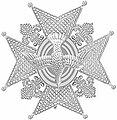
Ferdinand II was King of the Two Sicilies from 1830 until his death in 1859.
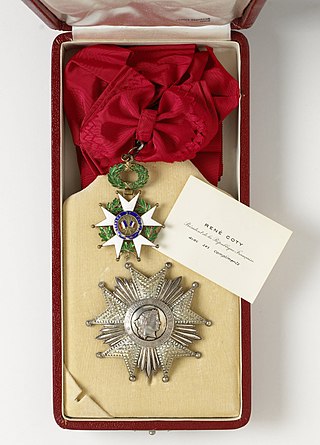
The National Order of the Legion of Honour, formerly the Royal Order of the Legion of Honour, is the highest French order of merit, both military and civil. Established in 1802 by Napoleon Bonaparte, it has been retained by all later French governments and regimes.
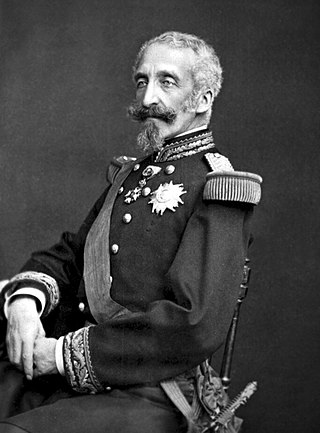
Prince Louis of Orléans, Duke of Nemours was the second son of King Louis-Philippe I of France, and his wife Maria Amalia of Naples and Sicily.
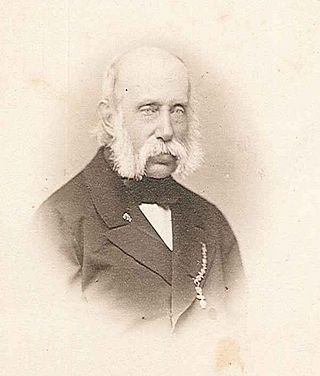
Archduke Franz Karl Joseph of Austria was a member of the House of Habsburg-Lorraine. He was the father of two emperors: Franz Joseph I of Austria and Maximilian I of Mexico. Through his third son Karl Ludwig, he was the grandfather of Archduke Franz Ferdinand of Austria – whose assassination sparked the hostilities that led to the outbreak of World War I – and the great-grandfather of the last Habsburg emperor Karl I.
The Ordre des Arts et des Lettres is an order of France established on 2 May 1957 by the Minister of Culture. Its supplementary status to the Ordre national du Mérite was confirmed by President Charles de Gaulle in 1963. Its purpose is the recognition of significant contributions to the arts, literature, or the propagation of these fields.
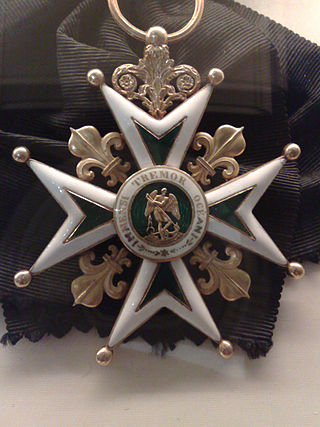
The Order of Saint Michael is a French dynastic order of chivalry, founded by King Louis XI of France on 1 August 1469, in response to the Order of the Golden Fleece founded by Philip the Good, Duke of Burgundy, Louis' chief competitor for the allegiance of the great houses of France, the dukes of Orléans, Berry, and Brittany. As a chivalric order, its goal was to confirm the loyalty of its knights to the king. Originally, there were a limited number of knights, at first thirty-one, then increased to thirty-six including the king. An office of Provost was established in 1476. The Order of St Michael was the highest Order in France until it was superseded by the Order of the Holy Spirit.

The Royal and Military Order of Saint Louis is a dynastic order of chivalry founded 5 April 1693 by King Louis XIV, named after Saint Louis. It was intended as a reward for exceptional officers, notable as the first decoration that could be granted to non-nobles. By the authorities of the French Republic, it is considered a predecessor of the Legion of Honour, with which it shares the red ribbon.

An order of chivalry, order of knighthood, chivalric order, or equestrian order is an order of knights, typically founded during or inspired by the original Catholic military orders of the Crusades and paired with medieval concepts of ideals of chivalry.
Commander, or Knight Commander, is a title of honor prevalent in chivalric orders and fraternal orders.

Jean Louis de Nogaret de La Valette (1554–1642), created Duke of Épernon, was a powerful member of the French nobility at the turn of the 17th century. He was deeply involved in plots and politics throughout his life.

Jean-Antoine de Mesmes, comte d'Avaux (1661–1723) was a premier president of the Parlement of Paris and member of the Académie française. As premier president he presided at the rescinding of the will of Louis XIV and in 1720 at the remonstrance against the regent, Philippe of Orléans, for allowing Law's disastrous financial scheme and appointing Guillaume Dubois as archbishop of Cambrai.
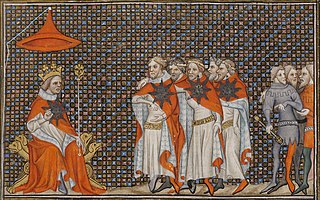
The Order of the Star or Company of the Star was an order of chivalry founded on 6 November 1351 by John II of France in imitation of the Order of the Garter founded in 1348 by Edward III of England. The inaugural ceremony of the order took place on 6 January 1352 at Saint-Ouen, from which it is sometimes called the Order of Knights of the Noble House of Saint Ouen.
This page is a list of the orders of chivalry and orders of merit awarded by France, in the order they were established or incorporated in France, and their origins.

Jean-Jacques de Mesmes, comte d'Avaux, vicomte de Neufchâtel (1630–1688) was a French magistrate, intendant of Soissons, and Président à mortier of the Parlement of Paris. He developed the town of Avaux-la-Ville, which is now called Asfeld. He was a member of the Académie française. He was brother of Jean-Antoine de Mesmes, the diplomat, and father of Jean-Antoine de Mesmes, the premier president of the Parlement of Paris.

A cordon bleu or schnitzel cordon bleu is a dish of meat wrapped around cheese, then breaded and pan-fried or deep-fried.

The Military and Hospitaller Order of Saint Lazarus of Jerusalem is a Christian order that was statuted in 1910 by a council of Catholics in Paris, France, initially under the protection of Patriarch Cyril VIII Geha of the Melkite Greek Catholic Church. During the 1920s, it expanded its jurisdiction and enrolled members from other countries in Europe and in the Americas. It re-established the office of grand master in 1935, linking the office to members of the Spanish branch of the House of Bourbon. It assumed an ecumenical dimension during the 1950s to expand its membership to individuals of other Trinitarian Christian denominations in British Commonwealth countries.

Hervé Pinoteau, 6th Baron Pinoteau was a French historian, expert in heraldic research and royalist apologist. He was the author of more than 900 articles and 22 books primarily on history and heraldry.

Admiral Georges Cabanier was a French Naval Officer and Admiral, in addition to Grand Chancellor of the Legion of Honour.

Jean-Antoine de Mesmes, called d'Avaux (1640–1709), was a French diplomat in the service of Louis XIV. He is probably best known for accompanying King James II of England in his Irish expedition. He also negotiated for France the Peace of Nijmegen, which ended the Franco-Dutch War (1672–1678). He was French ambassador in Venice, The Hague, Stockholm and finally The Hague again.

The collar of the Order of Saint Michael is a chivalric collar which was attributed as the most prestigious insignia to the knights of the Order of Saint Michael until 1830. This collar is now extremely rare. Only three are now known to exist, all of which would have been awarded to Dutch notables in the years 1650–1660 as a sign of appreciation for their faithfulness during the Thirty Years' War.







